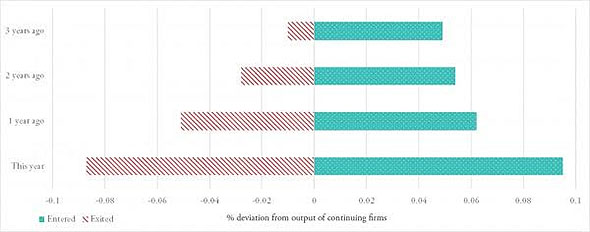
Content supplied by Motu*
Previous studies of the New Zealand construction industry have found poor productivity performance. However, a new study from Motu Economic and Public Policy Research -- a not-for-profit, non-partisan research institute -- uses data from individual firms to dig deeper into this issue.
“Weak productivity growth in construction has been a concern for some time,” said Dr Adam Jaffe, Director of Motu and a researcher on the project. “What we found, however, was that many individual construction firms—particularly new entrants—exhibit healthy productivity levels.”
Looking at labour productivity (or the amount of value added per worker) the average construction firm improved 1.7 percent annually, compared to 0.5 percent for all New Zealand businesses.
“As with other industries there is a considerable gap between the best and worst performing firms. However, lower performing construction firms have slightly higher productivity than firms in the primary and manufacturing sectors,” said Dr Jaffe.
“So what we found was that the lower overall average labour productivity in construction is associated with a relative absence of star performers, rather than with an over-abundance of underperformers,” said Dr Jaffe.
The study also measured multi-factor productivity growth, which takes account of a wider variety of inputs and then measures how well each firm is using those inputs in generating output.
“The construction industry did well in multi-factor productivity too, growing by 0.5 percent annually, compared to 0.1 percent annually for New Zealand businesses more generally,” said Dr Jaffe.
This analysis also considers other things that affect a firm’s output such as its location, age, sub-contracting history and whether the firm is entering, continuing in, or exiting the industry.
“We found that high-productivity construction firms tend to be younger, or a new start-up. They are also more likely to be based in Auckland than low-productivity firms,” said Dr Jaffe.
“This is contrary to much of the received wisdom from industry-level studies that says that frequent firm turnover is a drag on productivity. What we found by analysing firms within the sector, was that new firms are on average more productive than incumbent firms.”
On the flip side, firms exiting the industry tend to have lower productivity, so their departure also serves to raise the average.

The research also found that large construction firms who do the more commercial jobs are more productive.
“The largest positive contributors to multi-factor productivity growth in the overall construction industry were existing productive firms gaining a bigger share of the market, low-productivity firms exiting the sector, and new high-productivity firms entering the industry,” said Dr Jaffe.
Construction firms have an average of three workers, compared to the New Zealand average of five workers. But there is wide variation, with 71% of construction firms having only a working proprietor with no other employees. At the same time, a few large firms account for most of the overall industry employment and output.
“Working-proprietor-only firms are slightly less productive on average than firms that employ other workers, but exhibit greater productivity variation, with some very low and some very high performers,” said Dr Jaffe. “There’s an image that owner-operators only want their boat, their beamer and their bach, and don’t feel the need to keep increasing their productivity. But there is no evidence that this happens more in construction than in other sectors.”
Measuring productivity isn’t easy. For example take two builders, who have the same number of employees, build houses from exactly the same materials and are located in the same area, but one is far more successful. How do we quantify what is making the difference?
“How we measured productivity involved looking at the differences between firms within a sub-industry and accounting for differences in output, several types of inputs, and other firm characteristics,” said Dr Jaffe. “That’s only possible with the sort of data we were lucky enough to access through the Longitudinal Business Database. This is the first time anybody has used the LBD to look at the construction sector in detail and we think it will be useful across many different types of industry, from primary up.”
The Longitudinal Business Database contains financial data, merchandise and trade data, information on business practices and outcomes, along with demographic characteristics, business activity and performance. The research looked at approximately 358,000 yearly observations of 78,000 construction firms.
Dr Jaffe, Trinh Le and Nathan Chappell then made comparisons between different firms using these data, which provided micro-level patterns that showed real change. This is the first study internationally that uses micro-level data to analyse productivity in the construction sector.
The independent report Productivity distribution and drivers of productivity growth in the construction industry by Adam Jaffe, Trinh Le and Nathan Chappell was funded by the Building Research Levy through BRANZ and the Productivity Hub.
You can receive all of our property articles automatically by subscribing to our free email Property Newsletter. This will deliver all of our property-related articles, including auction results and interest rate updates, directly to your in-box 3-5 times a week. We don't share your details with third parties and you can unsubscribe at any time. To subscribe just click on this link, scroll down to "Property email newsletter"and enter your email address.
1 Comments
"Measuring productivity isn’t easy. For example take two builders, who have the same number of employees, build houses from exactly the same materials and are located in the same area, but one is far more successful. How do we quantify what is making the difference?"
The answer to your question could be something as simple as one firm is compliant with all the rules while the other isn't.....(electrical tagging of tools, H&S meetings and training, etc) One firm may have a better accountant than the other. Variations to job, travel distance from job site, waiting on a bureaucrat, general delays......2 qualified carpenters with 1 apprentice vs 1 qualified and 2 apprentices will also have a bearing when making comparisons.
"The research also found that large construction firms who do the more commercial jobs are more productive." I am sure there is a very simple explanation for this.....and it is not because people work harder or faster in the commercial area....maybe a wee look through the building code and legislation would be helpful!
We welcome your comments below. If you are not already registered, please register to comment
Remember we welcome robust, respectful and insightful debate. We don't welcome abusive or defamatory comments and will de-register those repeatedly making such comments. Our current comment policy is here.